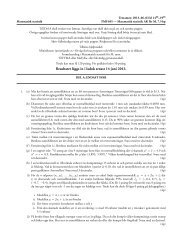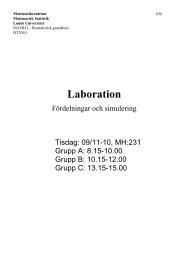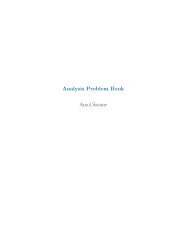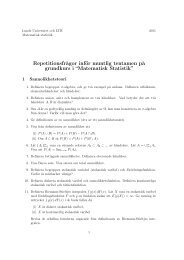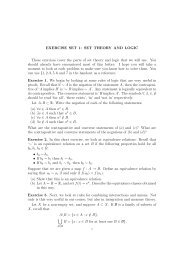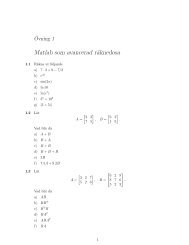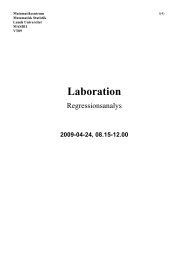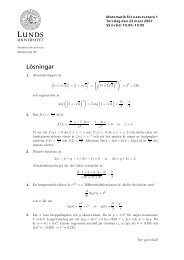Correspondence of Marcel Riesz with Swedes. Part II. file: Riesz1.tex
Correspondence of Marcel Riesz with Swedes. Part II. file: Riesz1.tex
Correspondence of Marcel Riesz with Swedes. Part II. file: Riesz1.tex
You also want an ePaper? Increase the reach of your titles
YUMPU automatically turns print PDFs into web optimized ePapers that Google loves.
0.4. ALFRED LILJESTRÖM 25<br />
After my return from Copenhagen I made some measurements in order to be able to<br />
master numerically fhe top’s special inertia properties. It turned out that one from the<br />
above equation comes to the following more special equation holding for the nutation limits<br />
<strong>of</strong> the top:<br />
1 − q 2 = 2mglAu −<br />
R 2 0<br />
(1 − qu)2<br />
1 − u 2 = 0,<br />
provided one assumes that, at the start, the top has its axis nearly horisontal and there is<br />
no translatory motion.<br />
A simple calculation shows that in this formula the fractal expression for u = q takes<br />
its minimal value 1 − q 2 or exactly the value that linear expression in the formula takes<br />
for u = 0. Geometrically, this means that for large values <strong>of</strong> R 0 , e.g. if the top’s initial<br />
spin is sufficiently large, then the straigt line meets the cubic in two points which lie very<br />
close to the value u = q. This in turn implies that the braking <strong>of</strong> the top <strong>with</strong> some<br />
approximation follows the formula<br />
R z = R 0 cos θ<br />
The nutation theory that I presented in Copenhagen can thus beused to follow in<br />
detail the top’s curious brakning process. It gives likewise a striking verification <strong>of</strong> what<br />
I also said in Copenhagen, among other things, namely that the pivot motion <strong>of</strong> the top<br />
<strong>with</strong> its centre <strong>of</strong> gravity displaced by no means contradicts the existence <strong>of</strong> two nutation<br />
limits, so that the phenomen evoced by you corresponds to the case when both limits<br />
coincide, the straight line being tangent to the cubic.<br />
I understand now very well that you now, after havig taken part <strong>of</strong> my results in<br />
my first letter, gladly want to arrive to them along more elementary paths, because you<br />
find the nutation theory complicated. The attempt to an “elementary theory”, as your<br />
son presented in his letter, and which you refer to, gives me some doubts. To start,<br />
<strong>with</strong>out further ado, from formula R z = R 0 cos θ and then say that one can by “se bort<br />
fra tyngdenutationerne, umiddelbart vise at θ vil variere omtrænt lineært med tiden” 10<br />
(neglect the weight nutations immediately show that θ varies inversely linearly <strong>with</strong> time)<br />
seems to mean that by assuming θ constant one can show that θ varies linearly <strong>with</strong> time.<br />
Moreover, the presentation, it seems me, is based on the misunderstanding that gravity<br />
alone causes the nutations. This is not the case. If one puts the gravity constant g equal<br />
to zero in the nutations equation, then it is only one little term that vanishes, all the other<br />
remain and witnes that the laws <strong>of</strong> natures are such that inertia properties <strong>of</strong> the ball-top<br />
can give rise to complications.<br />
I am tempted to quote Poincaré/’s famous reply to Felix Klein: “Voilà une difficulté<br />
dont on ne triomphe pas en quelques lignes!” (French, Here is a difficulty that one does<br />
not overcome in a few lines!)<br />
10 Editor: This quote is in Danish.




